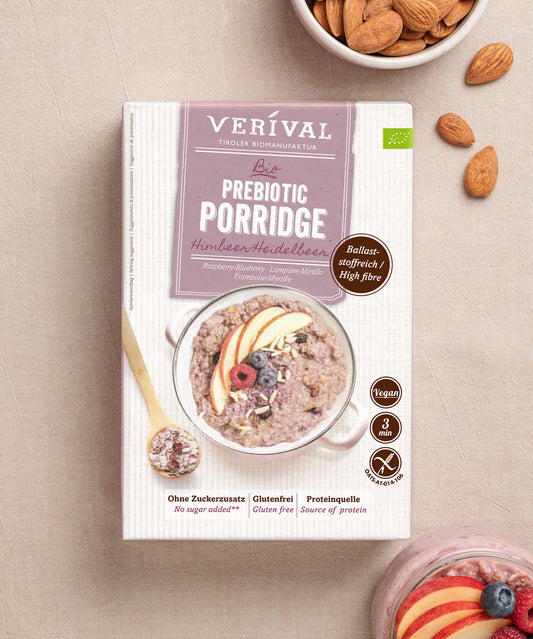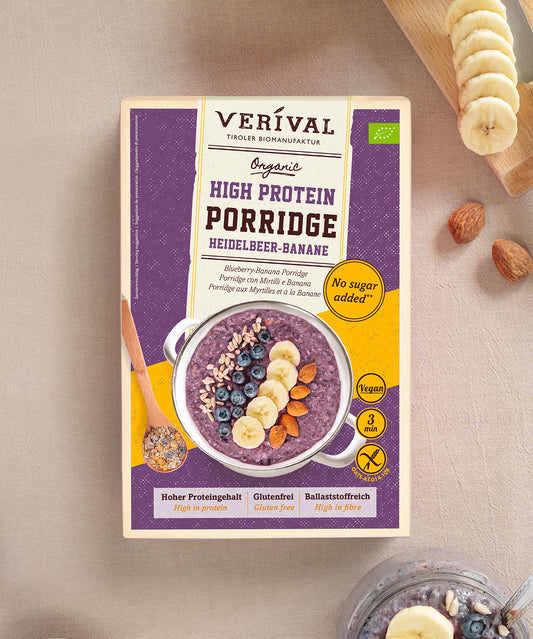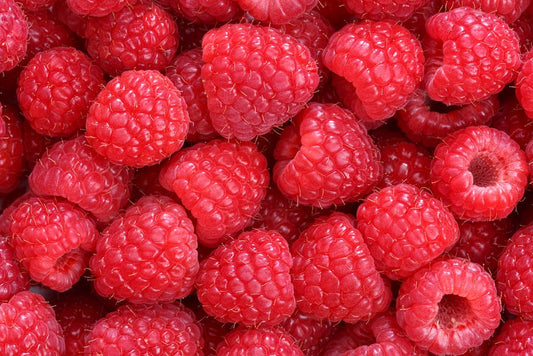Have you heard of overnight oats? An alternative way of preparing oats. You simply prepare them in the evening, add fresh toppings in the morning and can enjoy your oat breakfast in peace.
Find out more about overnight oats, how healthy they are, what benefits they have and get inspired by our delicious ideas.
Overnight oats for breakfast – find out more!
What exactly are overnight oats?
If you're interested in healthy eating, you can't ignore oats. Overnight oats are basically nothing more than cold porridge. They taste very similar to warm porridge. They are a great and healthy breakfast. The only difference is that the oats are eaten cold.
Overnight oats consist of oat flakes that are poured with cold milk, a milk alternative or water. Soaked oat flakes are high in fibre, full of minerals and vitamins and contribute to a healthy diet.
How are overnight oats prepared?
Preparing overnight oats couldn't be easier. The flakes are mixed with the liquid and left in the fridge overnight. The liquid causes the oats to swell during the night, creating a creamy porridge.
The ratio of oats to liquid should be approximately 1:2. So, 50 grams of flakes requires 100 millilitres of liquid. But it is entirely up to you how you prefer the consistency of your overnight oats. The next morning, you can refine the porridge with fruit, nuts, seeds, dried fruit, coconut flakes or nut butter. Your taste decides how you want to design your oats.
Sealed containers are particularly suitable if you want to take the porridge with you to work. A healthy breakfast at work will help you to concentrate.
The whole thing can also be prepared gluten-free with gluten-free flakes. Dairy-free alternatives create a vegan option, which, with lots of nuts, is also high in protein and essential fatty acids.
Overnight Oats - Read more now!
Why are overnight oats so healthy?
Overnight oats, oats and porridge are also known as power breakfasts. This is due to the numerous calories that breakfast contains.
One serving contains an impressive 400 to 600 calories. The number of calories depends on which toppings and which fruit you use. However, you shouldn't fixate on the number of carbohydrates or calories.
Oats have many healthy benefits. Oats are high in fibre, which makes them particularly filling. This prevents you from reaching for the snack box before lunch.
We'll show you an overview of all the benefits of overnight oats:
- Oats stimulate your digestion
- Low impact on blood sugar levels thanks to complex carbohydrates
- Reduction of cravings
- High amount of plant-based protein, ideal for athletes
- No added sugar, but you can sweeten them with fruit or a natural syrup
- Numerous minerals and plenty of protein
What's more, oats are full of unsaturated fatty acids. If you serve them with berries and almond butter, for example, you will also get plenty of antioxidants and other minerals.
Have you heard? Overnight oats against cellulite!
Most women suffer from cellulite – it's perfectly normal. It can't be completely eliminated, nor does it need to be. But with exercise and a healthy diet, you can have a positive effect on cellulite if you want to.
Oats are full of valuable proteins and fibre. Both are essential for building muscle. The muscles in turn strengthen the connective tissue.
Of course, you can support the effect by exercising regularly. The unsaturated fatty acids and antioxidants also have a positive effect on your skin.
Proven toppings to go with overnight oats
As already mentioned, porridge thrives on extravagant toppings. We'll show you how to turn your overnight oats into your favourite breakfast, step by step.
Oats as a base
The flakes are, of course, the basis for healthy overnight oats. They are the first ingredient. The oats are first placed in a (sealable) jar or bowl. There are two types of oats: coarse and fine.
If you want something a bit chewier, you should opt for the coarse flakes. The fine flakes will give you a creamier porridge. The ideal amount is between 40 and 60 grams, depending on how hungry you are.
Don't like oats? You can use another type of grain instead. How about spelt flakes, buckwheat flakes, millet flakes or even chia seeds?
The choice is huge. The protein-rich quinoa is also a great alternative.
Discover Verival Overnight Oats
Fibre with various seeds
If you want to consume as much fibre as possible, you should add flax seeds, chia seeds, hemp seeds or psyllium to your porridge.
Fibre stimulates your digestion. It also contains many nutrients such as magnesium, calcium, iron and vegetable protein. It also contains essential fatty acids such as omega-3.
If you have problems with your gastrointestinal tract or suffer from irritable bowel syndrome, you should add some psyllium seeds to your porridge.
It doesn't always have to be cow's milk
You need about 120 millilitres of milk for your oats. If you prefer it more liquid, you can of course add more milk. You can use milk or plant-based alternatives such as oat drink, almond milk or soy milk.
There is a wide range of milk alternatives to choose from. If you like it a little sweeter, you can use oat or rice milk. Do you prefer a nutty flavour? Then almond or hazelnut milk is perfect for you. You don't need any cow's milk at all.
Of course, you can just use water or a delicious juice.
Toppings for that extra crunch
Since the porridge is very soft, you can add a crunchy component. Cocoa nibs, coconut flakes, nuts, seeds, pumpkin seeds or granola are all good options.
You can easily make your own granola: simply mix oats with seeds. Then mix with coconut oil or sunflower oil, honey or another sweetener. Now add spices of your choice and bake in the oven at 200 degrees for 20 minutes.
If you are less keen on experimenting in the kitchen, take a look at Verival's crunchy muesli. All varieties are gently baked without palm oil – there is a huge selection to choose from.
Vitamins with lots of fruit
Of course, fresh fruit should not be missing. Whether apples, bananas or the reduced-sugar version with berries, fresh fruit is full of vitamins. But for the sake of the environment, you should make sure to use seasonal fruit.
Of course, you can also use frozen fruit. You can simply cut the fruit and add it or make a kind of puree. To do this, simply blend the fruit.
If you prefer a particularly filling breakfast, you should opt for bananas. Berries or citrus fruits, on the other hand, are suitable for the lighter option.
























